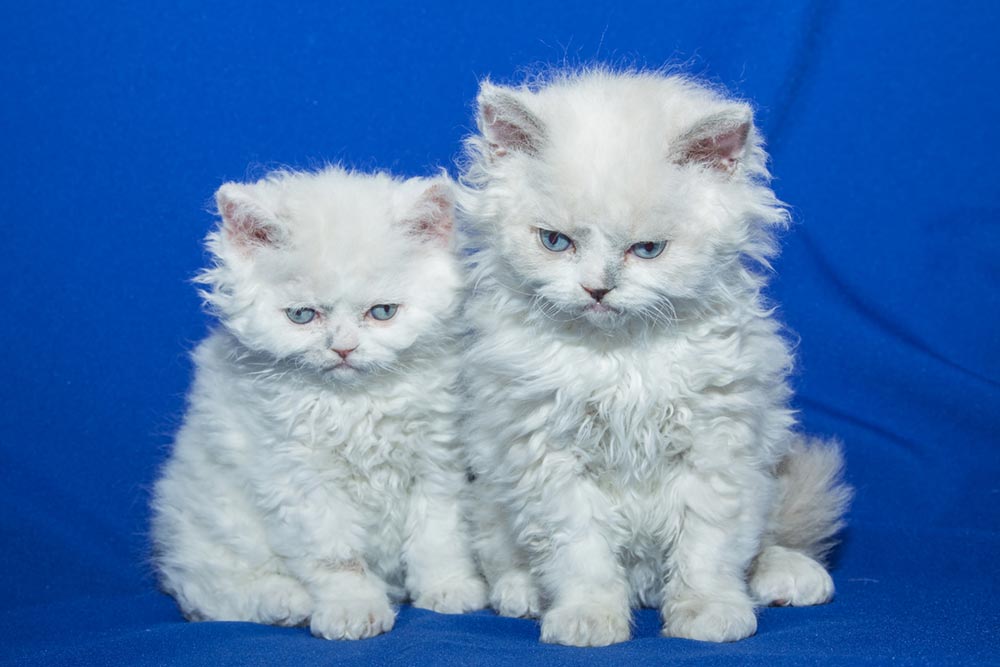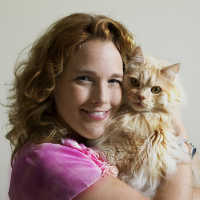The curly-haired cat has taken the Internet by storm. If you didn’t know it, you probably wouldn’t believe it. But yes, cats can have curly hair. This adorable fur pattern isn’t limited to one breed, but over multiple. Curly-haired cats can have long or short fur. Surprisingly, curly-haired cats are also called poodle cats!
What causes curly hair in cats?

Fur comes in all shapes and patterns, but it’s all determined by genetics. Your cat receives half its DNA from each parent, forming a unique feline. Curly coat is a genetic mutation.
While the origins of each breed to curly-haired cats is different, each started with a spontaneous genetic mutation which was passed down onto its offspring. Usually, curly hair is a recessive trait, meaning the cat needs two copies of the gene for it to show. However, spontaneous mutations happen, which can create an unintended curly-haired feline. The mutation changes structures in the group and cross-sections of individual hairs, leading to the appearance.
Most common curly-haired breeds
“Rexed” breeds are by far the most common to have curly hair in felines. There are four Rexed breeds internationally recognized: Cornish Rex, Devon Rex, LaPerm, and Selkirk Rex. Different mutations create the curly coat, causing a difference in appearance.
Cornish Rex

This breed is known as the “Greyhound” of cats because of the slender build and leg. Their coats are usually thin, with large ears. They remain playful throughout their life. A tortoiseshell barn cat in England created the curly-haired breed. Out of the five kittens, a male came out with a fine and curly coat. Over the years, it’s been isolated and duplicated. Scientists narrowed down the gene to an issue with synthesizing a protein called LPAR6, which gives guard hairs strength.
They have fur that can be tightly curled or crimped. Their whiskers can also be curled! Their coat is missing the guard hairs, which compose the outer coat for most cats.
Devon Rex

The Devon Rex’s coat is like the Cornish Rex. While considered hypoallergenic, they are not. This breed was discovered in England. Unlike Cornish Rexes, Devons do have guard hair, but very little. The genetic mutation is a splice variant in KRT71, a study found.
The breed is active and playful, who can jump high. They prefer high places. Normal face features include large, rounded ears and upturned noses. Their whiskers are short and often curled. Strangely, the breed enjoys cuddling near the neck or head of their human companions. Devons typically have one person to whom they are devoted.
LaPerm

Despite the different name, the LaPerm is another Rex breed. Their name is associated with the curly hair, with tighter curled on the throat and base of the ears.
The breed originated in the United States as a spontaneous mutation is cats used to pest control. However, the gene which causes their curly coat is dominant. The fur comprises soft waves, curls, and ringlets, but each cat’s is different. The texture isn’t silky, but has a drag on the hand.
They have an athletic build and are outgoing.
Selkirk Rex

The Selkirk Rex isn’t related to the other Rex breeds. The largest difference is their hair is of normal length. Their hair is plusher and thicker than the LaPerm. The breed originated in Montana with a litter born to a rescue cat.
The genetic mutation in the Selkirk is an incomplete dominant. If a cat gets one copy of the gene, they may have a fuller coat. However, those with two copies may have a tighter curl and less volume. Over the years, the breed has developed short and long coats.
Their head is round, with large eyes and a distinct muzzle. Because of mating with other breeds, the temperament is laid back, cuddly, and playful.
Munchkins

The Munchkin is a newer breed of cats characterized by its short legs, caused by a genetic mutation. The breed originated in Louisiana from a stray cat whom had a litter with short legs, but it wasn’t accepted by the International Cat Association until 1991.
The breed is outgoing and intelligent. The influence of their short legs on jumping and running abilities is debated.
This breed doesn’t produce curly hair on its own. Curly hair happens when bred with a curly coat, such as the Rexes.
The Skookum is a hybrid of the Munchkin cat and the LaPerm. This cat breed features the curly hair on a small body. They are known for happy-go-lucky and intelligent personality. The breed loves to spend time with people.
American Wirehair

American Wirehairs are descended from American Shorthairs, with a spontaneous mutation causing the curly fur. The breed has a powerful, large body with round faces and short ears.
The Cat Fanciers’ Association considers American Wirehairs to be low-maintenance who are affectionate with owners. They have quiet voices and prefer to stay indoors.
The coat is like the American Shorthair, but has a crimped texture. It is dense, making the texture feel hard. It becomes longer during the winter.
Siberian

The formal name is the Siberian Forest Cat or the Moscow Semi-Longhair. This breed is considered more hypoallergenic because it produces less of the Fel d1 protein. The fur itself contains all three layers, but the awn hairs are thin and wavy.
They are agile jumpers, with strong hindquarters and large paws. Their chests are barreled with stocky builds. Their back has a slight arch because of a length difference between the hind versus the front legs. The felines are alert and adventurous.
Chantilly-Tiffany

This breed is rumored to originate as a cross between a Havana Brown and Abyssinian Longhair. Their coat is dense, but doesn’t have much undercoat. The long guard hair and awn hair is wavy on the flanks, neck, and underbelly. It grows wavier in the winter.
These felines often overgroom themselves, which can result in bald patches. Chantillies need a lot of attention and socialization compared to other breeds.
It tends to have a broad, wedged head with a strong muzzle. In 2012, the breed was facing extinction due to a fire destroying archives. The last ones were shipped to a breeder in Norway, but one kitten was produced. As such, the breed is considered extinct.
Are there any health issues associated with curly hair?
PKD
Polycystic Kidney Disease is a progressive disease that causes cysts to grow in the kidneys, inhibiting normal function. Signs rarely appear until a cat is 3 to 10 years old, but include changes in urination, increased water consumption, weight loss, and more. If untreated, it can lead to kidney failure.
HCM
Hypertrophic cardiomyopathy is thickening of the walls of the heart. This can create an abnormal heartbeat because it affects the heart’s ability to beat normally. If untreated, it can lead to breathing issues, blot clots, or death. Cornish Rexes and other breeds possess a gene which makes them predisposed to developing this disease. However, research cannot pinpoint whether the gene presence will guarantee the illness.
Coagulopathy
Coagulopathy is a condition in which affects the body’s ability to clot. It can manifest as an issue with excessive bleeding or clotting. Signs of the disease include unusual bruising, anal bleeding, loss of blood through the nose, and more. If you suspect your cat has this, you should schedule an appointment with a veterinarian.
Other Issues
The Cornish Rex burns easily compared to other cats, which means they need protection from the warmer weather. If their skin produces too much sebum, they could develop skin irritation. Some European cats breeds are prone to hair loss. Or some, like the Cornish Rex, are genetically predisposed to hair loss.
Rex cats often have issues with their teeth, likely related to an issue with the formation of proper dentition.
Are curly-haired cats hypoallergenic?
Curly-haired cats aren’t more hypoallergenic than other cats. Some breeds with curly hair produce less of the Fel d1 protein, but it’s not associated with the thinner fur.
How much does a cat with curly hair cost?
Because of the rarity, curly haired cats can cost between $1000-$5000 depending on the pedigree and other breeder determined characteristics. Those who will contain pedigree papers or breeding rights will be on the more expensive side.
It is rare to find a curly-haired cat in the shelter due to the rarity. The best way to get one of these beautiful felines is to go to a reputable breeder.
How do I care for a curly-haired cat?
The most important upkeep for a curly-haired cat is regular brushing or grooming. Daily brushing decreases shedding and how much hair the cat swallowing. Brushing can help decrease air-borne cat allergens.
You should inspect your cat every day for tangles or clumps. These could easily turn into mats, which would require further grooming to fix.
An undercoat rake would be helpful for curly-haired cats to help remove clumps of loose undercoat or smaller mats.
It’s hard to determine how often a cat should be bathed. Cats usually bathe themselves or each other, keeping them clean. However, cats with health problems could have trouble. It’s best to individualize bathing to what a cat needs.

